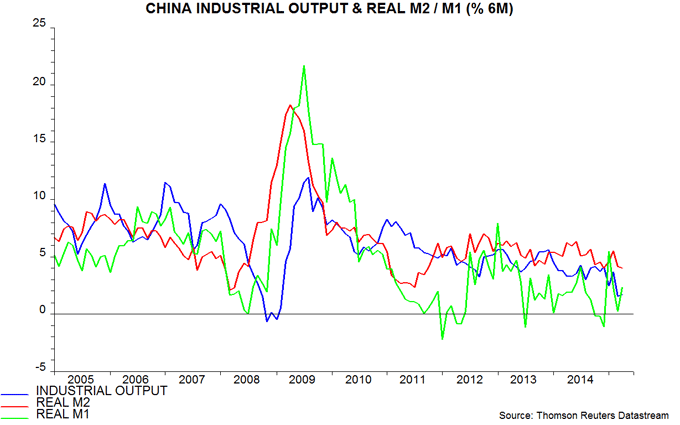Chinese money data: "true" M1 suggesting growth recovery
The Chinese economy remained weak in April but narrow money trends suggest a modest growth pick-up during the second half of the year.
The preferred measure of economic momentum here is the six-month change in industrial output*. This fell to just 1.6%, or 3.2% annualised, in March / April – the lowest since March 2009 and compared with average growth of 10.5% per annum in the five years to end-2014.
The extent of the slowdown was not clearly signalled by the official M2 and M1 money supply measures. Six-month growth of real (i.e. inflation-adjusted) M2 fell during the second half of 2014 but remained above its level in 2011, when the economy was significantly stronger than currently. Real M1 did warn of weakness, contracting in late 2014, but similar declines in 2012 and 2013 were not followed by falls in economic growth on the recent scale – see first chart.
The patchy forecasting performance of the official M1 measure reflects a flaw in its construction. M1 is conventionally defined as currency in circulation plus demand deposits. The Chinese measure, however, includes only demand deposits of corporations. This is a major deficiency at a time when policy is attempting to promote consumption- rather than investment-led growth.
The solution adopted here was to add a PBoC series for household demand deposits to official M1 to generate a “true” M1 measure. As expected, this performs better as a forecasting indicator. In particular, real “true” M1 contracted in late 2014, correctly warning of the recent slowdown, but did not give a similar negative signal in 2012 and 2013, when growth proved more resilient – second chart.
The six-month change in real “true” M1 has been volatile in recent months but averaged 1.8% (not annualised) over January-April, versus -0.1% in the last four months of 2014. This revival should be reflected in a recovery in economic growth over the summer / autumn.
*World Bank seasonally-adjusted index.



Reader Comments